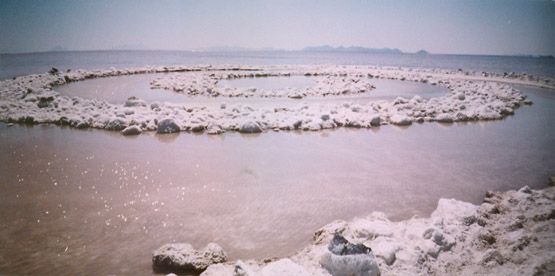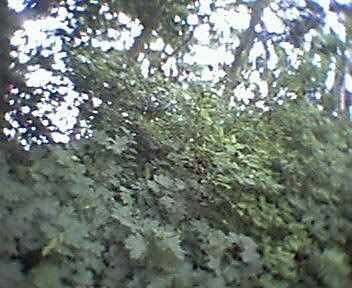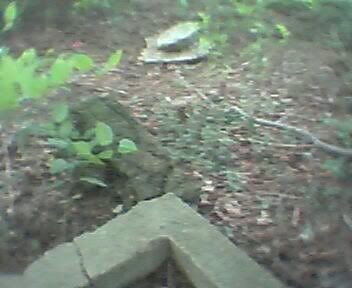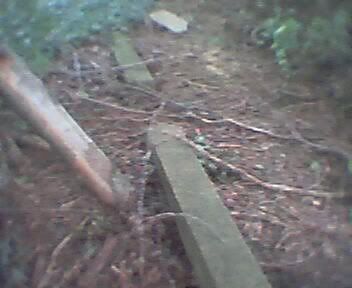
But from there, everything down. Robert Smithson dies in 1973 (still mourning you) and Nancy Holt wants the shed's remains to be preserved; two years later, 1975, an arsonist burnt down half of the structure. Kent State University must keep the piece, but officials hate it, considering it an "eyesore" (“something very ugly and offensive”, the definition says) and over the next decade campus workers removed all of the pieces that periodically fell to the ground (the image of men picking up and throwing away the pieces of the Woodshed that were periodically falling is an evocative if sad one that suggests man-made entropy)
At the same time, the Woodshed and its remains soared not only uglily in the uncultured eyes of KSU but in fame in the eyes of the art aficionados all over the world. The piece is debated in Kent and beyond, with ardent supporters (the art community) and haters on fire (the bureau of chiefs of Kent State University, the people of Ohio and elsewhere). Artists around the world traveled to Kent to visit the earthwork while people on campus and elsewhere considered it garbage. The virulent reactions that a ruined woodshed provoked in humans at that time are something to recall, if only to notice that they are nothing new- today those same feelings of hate and love are spread by the likes of Maurizio Cattelan, Damien Hirst or Tracey Emin. It's OK, it has to happen, human condition.
The same year of 1975 that saw the shed burn down, attacked, had a headline published on the Akron Beacon Journal crying to “Burn the Woodshed!” and bringing to the front page the discussions about the ill-fated work (even though the rednecks of Ohio, the Midwestern white trash, are not to blame exclusively; uncultured reactions against art fueled by ignorance are not exclusive of hick America, and in that sense, the case of the destruction of Richard Serra's Tilted Arc in Federal Plaza, New York, is well known).
The grade of polemic created by the piece and its controversy can be considered in the light of a surprising aspect of an earthwork: its monetary value, made from $10,000 by Smithson himself before he left the campus and upon transference of the work to the University to $40,000 by the KSU School of Art to $250,000 according to his New York gallery.
In January 1984, anyhow and despite of everything, the remains of the Woodshed were removed from the University, when an “errant snowplow”, rumor said, destroyed it completely. Professor Brinsley Tyrrell, who collaborated with Smithson in preparing the piece, has said nobody in the university realized the shed had collapsed and was gone for about six months, a fact that would diminish the role of the authorities in purposely destroying the artwork.
Today the remains are hidden in a grove of trees, most of which were planted some time ago to obscure the ruin. The grove is surrounded by the new Liquid Crystal Materials Science building, a football field, and a parking lot. A very dull, American place for an extraordinary site.

And yet, as with other human destructions, later on the demolished work is recuperated and celebrated: the Kent State University School of Art mounted an exhibition in 1990 on the earthwork, a “Smithson Inventory” with Partially Buried Woodshed-related materials has been gathered, the piece included in the faq’s of the campus web, a big photo of the big forested nothing/everything published on the web as part of “KSU attractions”. On my visit there the site was fenced in loud orange, probably to protect it from the excavations and constructions around (Michael Heizer style, by the way). The “Smithson Inventory” even keeps a “charred fragment of wood removed from Partially Buried Woodshed following the 1975 fire that destroyed half of the work”, kind of a souvenir of necrophilia.
For many reasons, seems natural to say the Woodshed was bound to disappear, doomed from the start not by entropy but human deliberate destruction. Even the series of disgraces and “unexpected” events that eventually destroyed the piece could be seen in the context of paranoia, crisis, political corruption and decay of the American 70’s. The Woodshed was the last of the victims: the dreams and hopes of the community-driven 70’s destroyed in the capitalist-individualistic-money-driven 80’s. Dreamers vs. authorities, again. Or dreamers turned to authorities.
The breaking of the woodshed has been linked to the breaking point that for America was the Kent State University shootings in May 4 1970. That breaking and collapse that was visible from the road inscribed with the deadly date and the authorities decided to erase. Now it is a forested mound, authority-made: to hide the piece by planting trees, the shootings, the story and history of Kent and all that happened there. But the appeal of the shed goes beyond the physical destruction of the piece and the useless and counterproductive for their intentions concealment of the site by the University: the location is now unmissable and unmistakable, a pretty visible beacon in the Kent campus, being a forested mound in an otherwise rather prairie environment. Furthermore, and as said, the University is for years now promoting and/or conserving the site. The human cycle of destruction-celebration.

Many have viewed the May 4 1970 shootings as the beginning of the Watergate and eventual destruction of Nixon: the collapse of the woodshed was felt beyond Ohio. The politicization and re-politicization of the earthwork is not a caprice but a necessity: that gesture of the student that chalked the forever-stuck-in-collective-memory date of May 4 1970 in the broken but resistant beam of the shed gave a whole new meaning to the work that actually transformed the piece and how was and is perceived, forever too. Thus, the accumulation of weight that made the central supporting beam to crack and the structure to fall and collapse, remaining partially buried under 20 cartloads of earth, is/was felt as the same kind of weight that, through the Kent shootings, converted a hippie movement into a world cry against war and, as said, the beginning of the very heavy accumulation of dirt that killed Nixon, politically.
All in all, there is this collective idea of the Woodshed, but everyone has its own. Contrarily as in the Jetty, where the actual physical piece, its own strong but subtle presence and the pilgrimage required to visit it copes the experience and makes it sort of uniform (the articles published by Jetty-visitors are more or less poetic and rich, but they all have in common a similar, shared experience: the landscape, the roads, the ruins, the oil jetty, the salt crust, the lunar aspect of the lake), the "Woodshed experience" lays more upon the personal disposition and state of mind than in the actual fact of being in what once was the Partially Buried Woodshed.
You walk in over the Jetty, but you walk on the site where the Woodshed once stood. The dialogue between the Jetty and Woodshed experiences is the one of site and non-site that made Robert Smithson famous, and the reality is that the non-site is probably more enticing than the site, for its lack of presence, for the power of its absence. For making possible to construct your own personal Woodshed, in contrast with the straightforward, in-your-face presence of the Jetty. The Jetty is there, take it. The Woodshed was there, invent it, reconstruct it in your mind and imagination. A mental evocation.
As that, the Shed entices the mind and fuels the creation of stories, remembrances around it. There's hardly anything to see, so we have to daydream. The Jetty is awe-inspiring, sublime and unearthly in all its earthness, a beyond-words experience, but already done and conducted- one just has to digest its gorgeous, powerful beauty. Anybody can appreciate the jetty; only an intelligent creative mind can have the ride of the shed. Fun vs. intellect. The jetty offers everything and the everythingness, leaving close to nothing to imagination. The shed offers close to nothing, leaving everything to imagination. Two ways of addressing and assessing an earthwork. Physical experience vs. mental experience.
I tend to compare, in a way, the mental visit to the Woodshed in Kent, Ohio to the one a knowledgeable traveler does to Germany. If you know that the vast majority of the ancient monuments in German cities are a post-war reconstruction that rebuilt what the Allies fire-bombed in the II World War destroyed almost completely, your mind and eye and way of seeing change completely and one starts to reconstruct in the mind how all that urban grid and churches and palaces and museums would have looked before 1940, when it was real and authentic.

It's most likely this mind-opening raison d'etre of the Partially Buried Woodshed that has made it into a fertile source of contemporary, current experiments in art. No less than four artists have reconstructed and appropriated the woodshed in the last decade, both metaphorically and physically and with various intentions and results.
The list is: Renee Green, Partially Buried, 1996; Tacita Dean, From Columbus, Ohio to the Partially Buried Woodshed, 1999; Sam Durant, Upside Down and Backwards, Completely Unburied, 1999; Mike Nelson, Tripe Bluff Canyon, 2004.
Sam Durant and Mike Nelson pay a direct homage to Robert Smithson's earthwork by meanings of literal and metaphorical reconstruction of the woodshed. In Durant's piece, a miniature model of the shed is packed with three CD players spitting loud music from The Rolling Stones, Nirvana and Neil Young. A monument to the young martyrs slain and a nostalgic, melancholic song to days gone. Mike Nelson reconstructs in actual size the woodshed, covered this time in sand, and makes it accessible, inviting to get inside and feel the physical opression and claustrophobia of the interior as well as the metaphorical overwhelmingness that restrained America in those weird 1970's that are felt by these two artists as sweet times lost.
Renee Green and Tacita Dean, on the other hand, use the Woodshed not to assess a respectful deference to Robert Smithson and his creation like the former artists but to tell their own stories and messages, giving a certain feeling that they could have used any other landmark of post-war art (specially in the case of Tacita Dean). Their renditions (rendering: "processing and manipulation of information in order to represent it") are problematic, raising questions of ethics and opportunity up to the point of being highly objectable, opposable and even rejectable.
Green’s complex installation, composed of videos, actual blocks of the foundation of the Woodshed, books, photographs and other objects, tries to confront her own past and experience, her time in Kent, the shootings, America and their fate; being an artist, being African-American, being a black artist in America. But in her account of her travel and her story, she supposedly brings from the site actual pieces instead of the photographs travelers (and tourists, and writers, and artists) normally do, thus not only destroying furthermore the heavily destroyed earthwork but decontextualizing those remnants in a treason of Smithson’s ideas:
"A work of art when placed in a gallery loses its charge, and becomes a portable object or surface disengaged from the outside world."
"I am not interested in art works that suggest "process" within the metaphysical limits of the neutral room."
(Truth is that, following Smithson’s strict statements, his own work shown in galleries at his time and the reconstruction and showing of his pieces done by the estate after his death betrays his spirit; also Durant and Nelson's pieces, and almost everything that we place within walls. But in the case of Green’s piece, it totally corrupts and kills any meaning that it could have for having supposedly appropriated of the ruins of a critical work of art)
Tacita Dean needs a special, final analysis. In fact, this essay that has gone through similar destruction and reconstruction and unforeseen events as the Woodshed to a point of trapping me inside the subject could have been titled "Partially Buried Brain: The Case against Tacita Dean".
Tacita is a British filmmaker, video artist and conceptual artist specialized in never making it despite being right on the spot (or never there). She crosses the world to get to hidden places just to slip away the high point, the climax, failing pathetically and being miserable in the name of video art and human condition. Tacita Dean deals on feelings of absence, loss, confusion, memory, deplacement, disappointment and (supposedly) tragic memories of a never-spotted treasure that has been long awaited.
The what-if and what-happened-to enticing feelings that disappearance and absence offer are understandably attractive. I let myself on them. Antoine de Saint-Exupery disappeared in his plane over the sea, never to be seen again, imagine the possibilities. Dutch artist Bas Jan Ader (a favorite of Tacita) was crossing the Atlantic sailing a boat, the conceptual piece of his life, from America to Europe when he missed contact and never was seen again. 33 years old, Exupery was 44. Myths to explore. The presence of the absence and the wide open field it allows to work in (human imagination, no less) is fertile and evocative: fictioning stories that never happened, imagining what could have occurred, staging different ends.
But Tacita Dean delivers an art of tricky nature, manipulative, false. If we ask for art to be true, Tacita is not it. The permanent loss and deplacement that she suffers while traveling and searching are part of a carefully orchestrated show (fake, so) . Some might find interesting her creation and recreation of moments of loss, confusion and tragic non-finding. But, more earthly, who would be stupid enough to be so close to the Spiral Jetty but renouncing to actually see it in order to make a video of it? (if she ever went there, or was the audio piece made in her studio in London? Do you believe her? How strong is your faith in her?)
Furthermore, who can be as **** to be walking around the foundation blocks of the Partially Buried Woodshed and pretend to be confounded and unsure to the point of suddenly suspend the search? Fiction and Fakeness shouldn’t be the same. If her video actually shows the site of the Woodshed and the artist denying being there for good, what should we think of Tacita? Fascination of her failure? Or plain irritation?
In her video From Columbus, Ohio to the Partially Buried Woodshed she travels from the Wexner Center for Arts in Columbus to Kent State University in Kent, Ohio to search for the site of the Woodshed, as said. Tacita Dean received the Wexner Center Residency Award in Media Arts in the 1997–98 season, and in response she created the Kent piece the following year of 1999. She was accompanied in her journey by a member of the Wexner, which makes the piece to contain not one but two dumb personas: an artist in permanent search of being lost in remote places and a curator that likes the game. She "successfully" finds the campus and that for being Tacita is a heroic deed. She goes around, asks a student, vague directions, all loosely, finds the grove of trees that hides the ruins of the woodshed, investigates, walks on the blocks, denies being there, "it's not it", "it cannot be it", leaves, video ends in the parking lot across the site. The habitual drama of imposture and fakeness- she is there, but she cannot be there, she must lose it or there will be no video!
As critic Tom Holert puts it: "despite all its exertion of control, its erudition and conceptuality, a tendency toward the self-indulgently moribund lurks through the highly elaborated texture of allegory and decay". Tacita loves to be a false loser and recreates herself on it. Her very meditated, controlled, conducted and manipulative art is well thought to lead to that inevitable failure- because she wants it, she makes it possible, no matter how, creating an already prepared destiny that compromises the Truth.
"Tragic fates and ruinous moments". What a depression. Her paraphrasis of Smithson and Kent is sad and risible. I went there, found the site of the woodshed, walked on it, strolled around, took a bunch of pictures and left from that same dull parking lot where Tacita stages her failure to New York to begin a new life with my wife. That can be much prosaic, but it is thoroughly true, authentic, real. Not to mention that we also found the Jetty.

